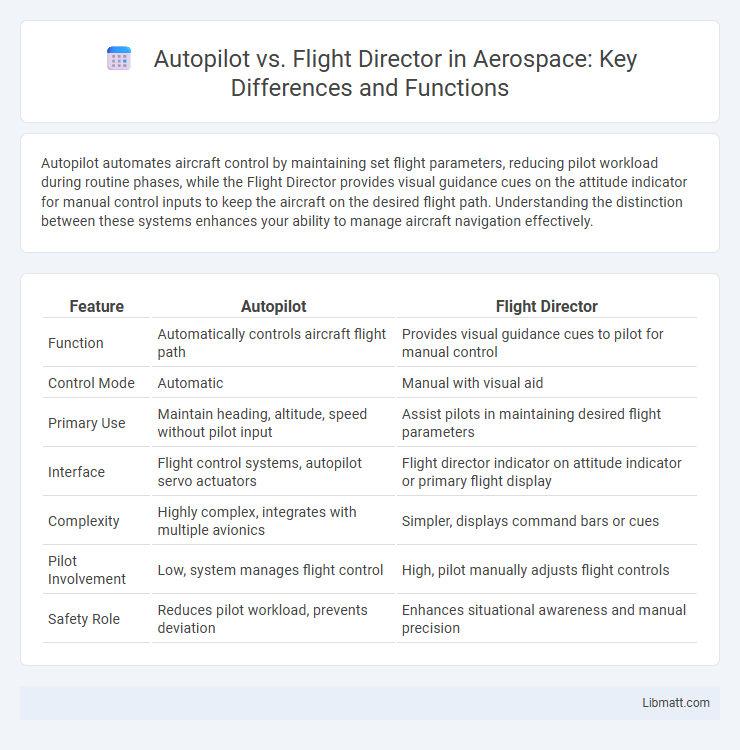Autopilot automates aircraft control by maintaining set flight parameters, reducing pilot workload during routine phases, while the Flight Director provides visual guidance cues on the attitude indicator for manual control inputs to keep the aircraft on the desired flight path. Understanding the distinction between these systems enhances your ability to manage aircraft navigation effectively.
Table of Comparison
| Feature | Autopilot | Flight Director |
|---|---|---|
| Function | Automatically controls aircraft flight path | Provides visual guidance cues to pilot for manual control |
| Control Mode | Automatic | Manual with visual aid |
| Primary Use | Maintain heading, altitude, speed without pilot input | Assist pilots in maintaining desired flight parameters |
| Interface | Flight control systems, autopilot servo actuators | Flight director indicator on attitude indicator or primary flight display |
| Complexity | Highly complex, integrates with multiple avionics | Simpler, displays command bars or cues |
| Pilot Involvement | Low, system manages flight control | High, pilot manually adjusts flight controls |
| Safety Role | Reduces pilot workload, prevents deviation | Enhances situational awareness and manual precision |
Introduction to Autopilot and Flight Director
Autopilot systems enable automated control of an aircraft's flight path, reducing pilot workload by maintaining desired headings, altitudes, or navigation courses. Flight Directors provide visual guidance cues on the attitude indicator, assisting pilots in manual flying by indicating the proper pitch and bank angles to follow a programmed flight path. Both systems integrate with avionics to enhance flight precision and safety, offering complementary functionalities in modern cockpit operations.
Defining Autopilot Systems
Autopilot systems are automated control mechanisms designed to maintain an aircraft's flight path without constant manual input, using sensors and computers to manage pitch, roll, and yaw. These systems improve flight safety and reduce pilot workload by executing programmed flight plans and adjusting aircraft attitude according to real-time data. Your understanding of autopilot is essential for differentiating it from the Flight Director, which provides visual guidance cues rather than direct aircraft control.
Understanding Flight Director Functions
Flight Director provides visual guidance cues to pilots by displaying command bars on the attitude indicator, helping them maintain the desired flight path manually. It integrates inputs from autopilot and navigation systems to calculate optimal pitch and bank angles for various flight phases. Pilots can use Flight Director independently to fly accurately when autopilot engagement is not preferred or possible.
Key Differences Between Autopilot and Flight Director
Autopilot and Flight Director serve distinct roles in aircraft control systems; Autopilot automatically maneuvers the aircraft based on preset parameters, while Flight Director provides visual guidance cues on the attitude indicator for manual pilot input. Autopilot reduces pilot workload by executing control inputs, whereas Flight Director enhances situational awareness by displaying optimal flight path commands without engaging automatic control. Understanding these differences ensures Your effective use of automation and guidance tools during various phases of flight.
How Pilots Use Autopilot vs Flight Director
Pilots use autopilot to automate the aircraft's control by following pre-set flight parameters, reducing workload during long or complex phases of flight. Flight directors provide visual guidance through cockpit displays, helping pilots manually adjust the aircraft's attitude, heading, and altitude by following command bars or cues. While autopilot executes commands directly, flight director serves as an advisory tool for precision manual flying.
Advantages of Autopilot in Modern Aviation
Autopilot systems in modern aviation significantly reduce pilot workload by automating routine flight tasks such as maintaining altitude, heading, and speed, allowing pilots to focus on strategic decision-making and situational awareness. Advanced autopilot technologies enhance flight safety through precise control inputs and integration with navigation systems, minimizing human errors during complex flight phases like approach and landing. These systems also improve fuel efficiency and flight consistency by maintaining optimal flight parameters, contributing to cost savings and environmental benefits in commercial aviation.
Benefits of Flight Director for Pilot Situational Awareness
Flight Director systems enhance pilot situational awareness by providing visual cues that guide the aircraft's attitude and trajectory, allowing pilots to maintain precise control even in complex flight conditions. Unlike Autopilot, which assumes control of the aircraft, Flight Director supports the pilot's manual flying skills by delivering real-time command bars on the primary flight display. This immediate feedback helps pilots quickly interpret flight path deviations and adjust inputs accordingly, reducing workload and increasing overall flight safety.
Limitations and Challenges of Autopilot Systems
Autopilot systems face limitations such as reduced effectiveness in complex weather conditions, unexpected turbulence, and system malfunctions, requiring vigilant monitoring by pilots. Unlike human-controlled flight directors that can adapt in real-time, autopilots may struggle with non-standard situations, leading to potential deviations from intended flight paths. System failures and sensor inaccuracies pose challenges, necessitating pilot intervention to ensure flight safety and operational success.
Flight Safety Considerations: Autopilot vs Flight Director
Autopilot enhances flight safety by automating control inputs, reducing pilot workload and minimizing human error during routine operations and complex maneuvers. Flight Director provides visual guidance cues on the attitude indicator, aiding your situational awareness and decision-making without automatically controlling the aircraft. Understanding the complementary roles of autopilot and flight director is critical in maintaining optimal safety and ensuring precise control throughout all phases of flight.
Future Trends in Aircraft Automation Systems
Future trends in aircraft automation systems emphasize the integration of Autopilot and Flight Director functionalities to enhance flight precision and safety. Advanced algorithms and artificial intelligence enable more intuitive, adaptive control, reducing pilot workload and improving situational awareness. Your cockpit will increasingly feature seamless interaction between these systems, supporting decision-making and enabling smoother, more efficient flight operations.
Autopilot vs Flight Director Infographic

 libmatt.com
libmatt.com